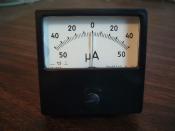A. Planning
Plan of the method to be used: -
The resistivity of nichrome can be determined using the equation ??=?RA/L
Where:
R:- Is the resistance of the wire in ?"ohms" and can be determined using the equation R=V/I where "V" is voltage in volts and "I" is current in
amperes.
L:- Is the length of the nichrome wire used in metres.
A:- Is the cross-sectional area of the wire in metres square and can be determined using the equation A= ??d2 where "d" is the diameter of the wire.
If I plot a graph of length on the x-axis against resistance on the y-axis. From the relation R = ? L /A which corresponds to the st. line equation ?
y=mx the graph should be a st. line passing through the origin where "m" is the gradient of the st. line graph and corresponds to ?/A. Since the cross-sectional area of the wire can be found by knowing itôs diameter.
Therefore the resistivity of nichrome can be calculated.
?
Diagram of the circuit used in this experiment
List of the apparatus used: -
1- Power pack supply of 4V
2-A variable resistor
3-A full scale deflection ammeter with a measuring range of 0-1 A
4-A digital voltmeter with a measuring range of 0-5 V
5-P, Q represents terminal blocks.
6-Circuit wires
7-PQ=Nichrome wire
8-A meter ruler
9-Michrometer screw-gauge
10-Sellotape
Detailed method: -
I set up the circuit as shown in the diagram that I have drawn. I started the experiment by taping a meter ruler between the terminal blocks P, Q so that I could measure 100cm of nichrome wire. I made sure that the wire was carefully tightened at both terminals to try to minimise the kinks or twists in the wire. I then switched on the...


